Exploring Norway by campervan: Everything you need to know
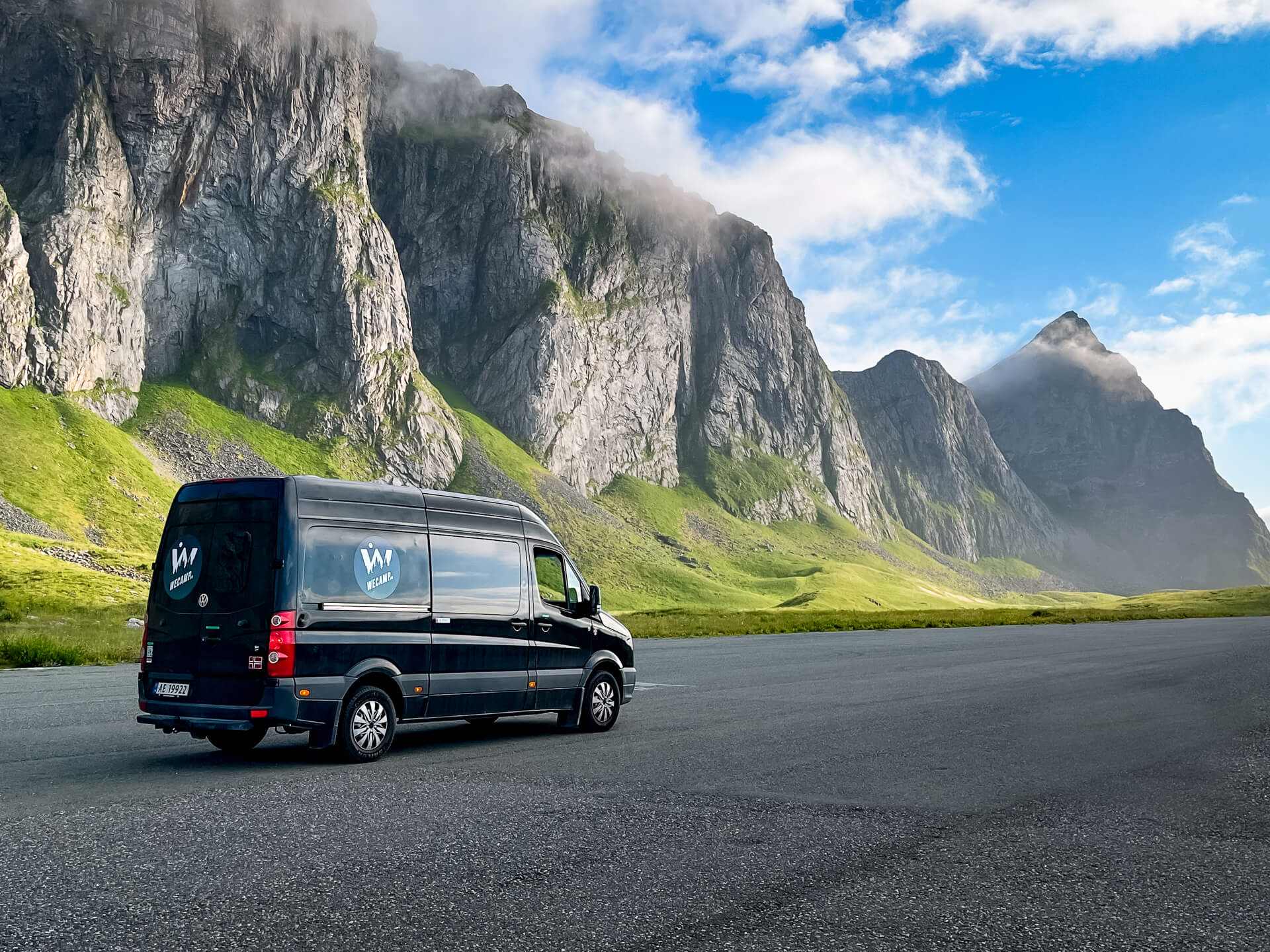
Driving through awe-inspiring landscapes, watching the Midnight Sun, falling asleep next to magnificent fjords and going for invigorating morning dips in the cold sea – this is what you can expect when exploring Norway by campervan.
There’s no doubt that one of the best ways to experience the natural beauty of Norway is to take a road trip through the country. With its jaw-dropping scenery, good roads and plentiful camping opportunities, Norway is a dream destination for motorhome and campervan travel.
What I love most about traveling with a campervan in Norway is the freedom it gives you. You can move at your own pace and have the flexibility to sleep wherever you want – whether it’s next to a beautiful sandy beach, a tranquil lake or a mountain.
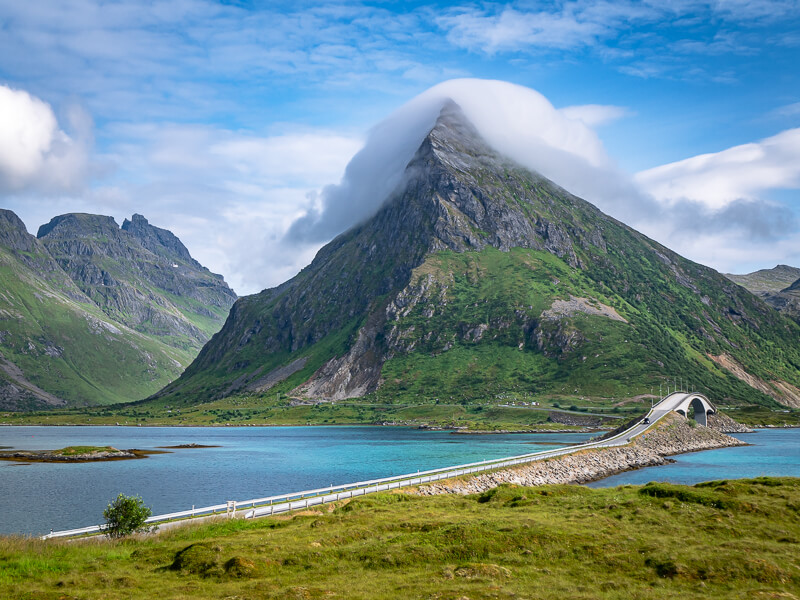
I took a 12-day campervan road trip through Northern Norway, discovering the natural wonders of Senja and the Lofoten Islands, and it was even more amazing than I ever imagined. These are the kind of places that make you wonder ‘How is this even real!?’.
In this guide, I’m sharing with you my best advice and tips for touring Norway by campervan, including driving tips, costs, where to go, where to stay overnight, the best time to visit, which campervan to rent and more.
Disclosure: This article contains affiliate links from which I may make a commission at no additional cost to you if you make a purchase.
Renting a campervan in Norway
Some important factors to consider when renting a campervan in Norway are the size of the van, the number of seats you need and which amenities you want to have.
Norway has many narrow roads, especially in the areas around the fjords and mountains. It’s much easier to drive a smaller campervan on these roads rather than a large bulky motorhome or a caravan.
With that said, we did see lots of motorhomes on our Norway road trip, so it’s certainly possible to get around with one if that’s what you prefer. You just need to be extra careful on those narrow roads and you might have a bit harder time finding parking.
Tip: If you’re planning to travel to Norway in the summer, which is the peak tourism season, book your campervan well in advance.
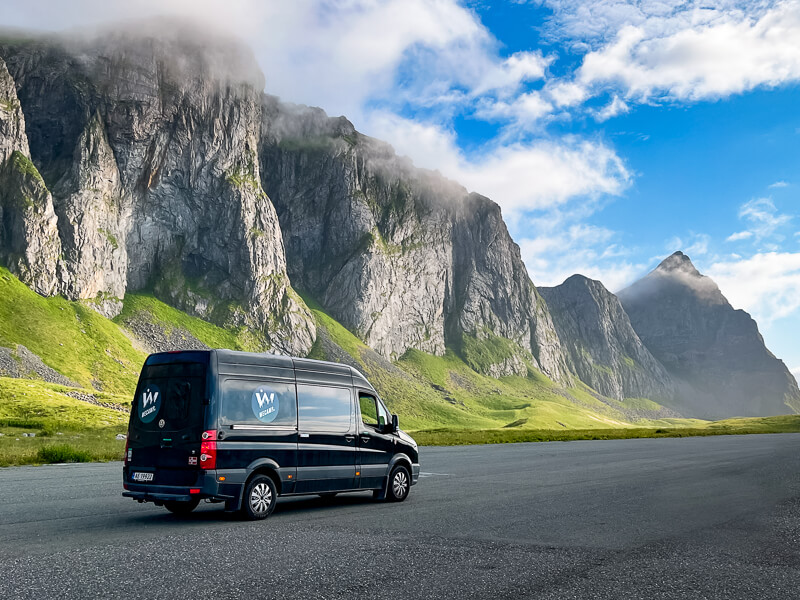
Our Wecamp van
We rented our campervan from a small local company called Wecamp and couldn’t have been happier with our experience. Our van was a converted Volkswagen Crafter with an automatic transmission. It was the perfect size for us and very comfortable to drive.
The main reason we decided to rent a campervan from Wecamp though was the beautiful interior of their vans. All Wecamp vans have bright wooden paneling which gives them such a cozy look. It feels like you’re inside a little cabin!
On top of that, their vans come with everything you need for your Norway road trip: a large comfortable bed, kitchen equipment, a tap, a heater, a fridge, camping furniture, power outlets and even a portable toilet. Another great thing about renting from Wecamp is that they offer unlimited kilometers so you won’t have to worry about any extra charges for driving long distances.
Take a look at Wecamp to see the prices and availability of their vans and remember to mention that you heard about them from me (The Smooth Escape) when making a booking!
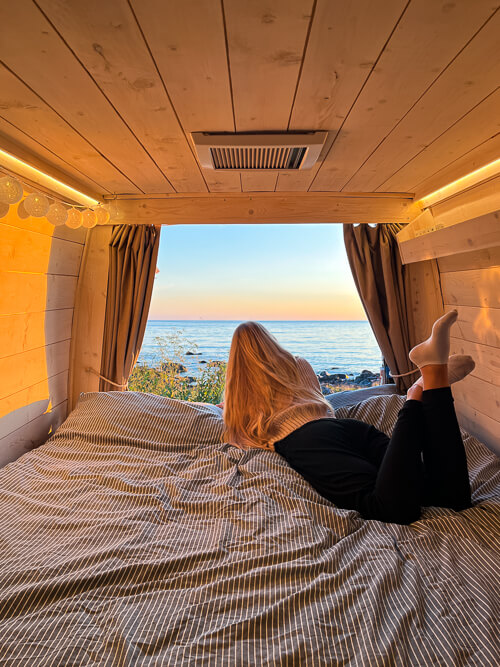
Norway campervan rental cost
The cost of campervan rental in Norway depends on the time of the year, the type of van or motorhome you want to rent and what’s included.
In general, the prices range from 150 EUR/night for a very basic camper in the low season to 300 EUR/night for a bigger camper in the high season. The van we rented was about 200 EUR/night.
With some companies, you have to pay extra for things like pillows, duvets and sheets, camping furniture, cleaning and extra kilometers.
Documents for campervan hire in Norway
You must have a valid passport and a driving license to rent a van in Norway. You can use your valid driving license from any country for up to three months in Norway.
However, in some cases, an international driving permit is required as a supplement to your driving license – for example, if your driving license doesn’t have a photo or if the information on your license is written in an alphabet other than the Latin alphabet.
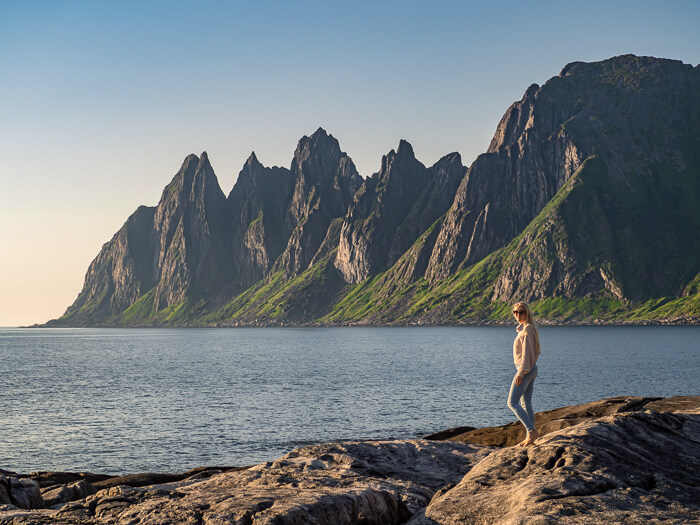
Campervan itinerary
One of the most exciting parts about planning your campervan road trip in Norway is deciding on the route you will take!
It might seem like an obvious choice to fly to Oslo (Norway’s capital) and start your campervan itinerary there. However, that’s not where you’ll find the spectacular nature of Norway.
If you want to cut down on some of the driving time, it’s worth taking a look at flights to Bergen, Ålesund or one of the airports near the Lofoten Islands (Tromsø, Bodø, Narvik) and renting a campervan there. These places are much closer to the stunning fjords and mountains of Norway.
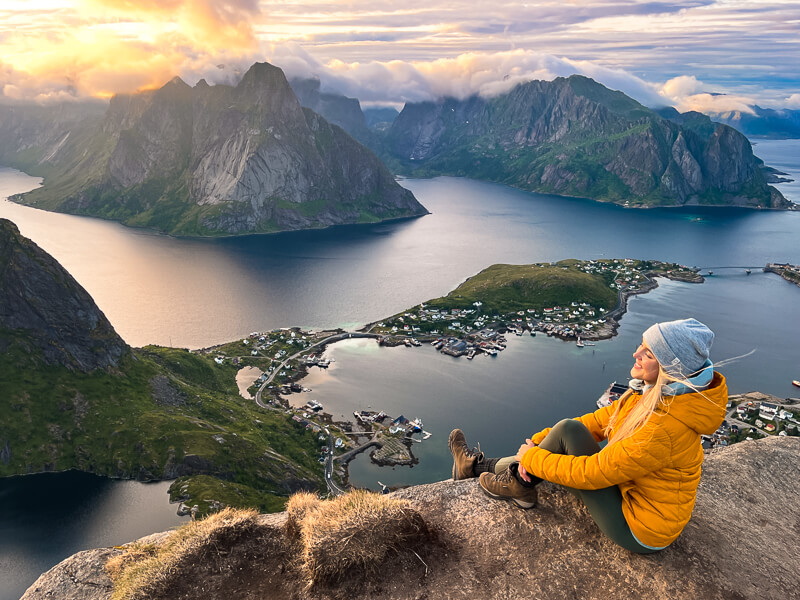
For instance, the drive from Oslo in the south to the Lofoten Islands in the north can easily take more than 20 hours. Unless you have ample time to spend in Norway, it would be a better idea to fly up there instead.
In our case, we flew to Tromsø in Northern Norway and rented our campervan there. We drove first to Senja Island and then to the Lofoten Islands and were absolutely astonished by the beauty of the landscapes in both of these places.
Be sure to check out my Lofoten Islands itinerary to get an idea of what to do and see in this amazing corner of Norway.
Tip: For more inspiration for planning your Norway itinerary, check out the Norwegian Scenic Routes. These are 18 selected roads which take you through some of the most beautiful scenery in the country.
Here’s a little video of our campervan trip in Norway:
Driving in Norway
Driving in Norway is a wonderful experience in itself. The roads are well-maintained, surrounded by striking views and the local drivers are calm and polite.
However, you shouldn’t underestimate how long it takes to drive around Norway with a campervan. It is the longest country in Europe and because of the numerous fjords, mountainous terrain and low speed limits, it can take a long time to reach your destination. When planning your Norway road trip, be sure to add some buffer to the driving times.
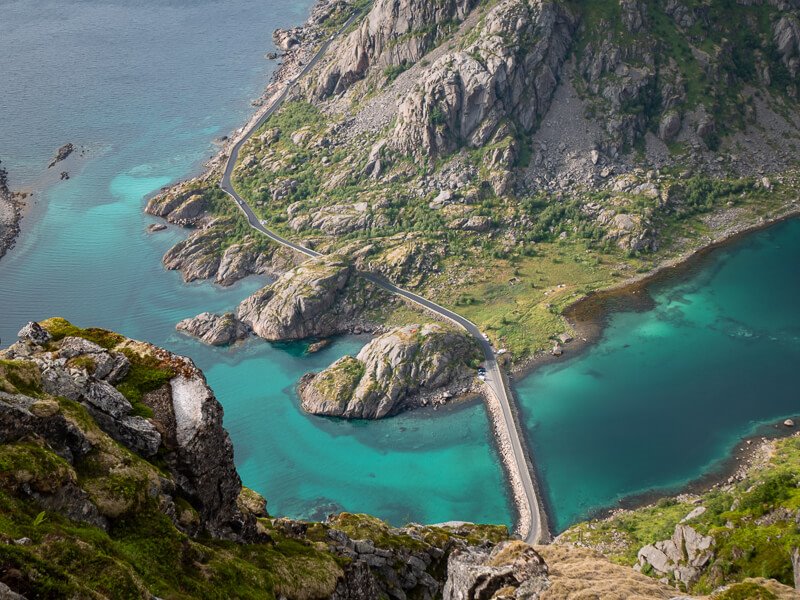
Roads in Norway
In general, roads are in great condition but some of them can be very narrow and curvy. Thankfully, these roads often have small roadside pull-outs or ‘pockets’, which you can use to let the oncoming cars pass.
You should also expect to see many tunnels and bridges when driving in Norway. Some of them have height and weight limits so remember to pay attention to the road signs.
On the larger motorways, the speed limits are usually between 90-110 km/h and on the single-lane roads outside the cities, they are 60-80 km/h.
There are also a lot of toll roads in Norway, especially between the bigger cities. If you are bringing your own van, you’ll have to register with AutoPass, which is the automated system for collecting toll payments. But if you are renting a campervan in Norway, it is most likely already registered with AutoPass.
We spent most of our time on the Lofoten Islands where there are thankfully no tolls.
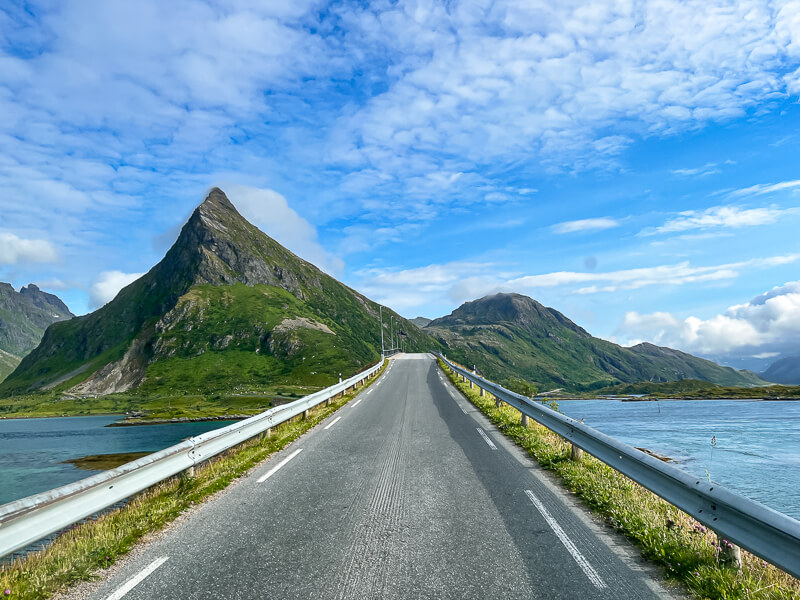
Ferries
Car ferries are an important part of Norway’s transportation system. You might want to take your camper van on a ferry to cross a fjord as it can significantly shorten the driving distance. Or you might want to visit some islands that are not connected to the mainland with a bridge.
Be aware that in the summer months, there might be long queues for the ferries and they often reach full capacity. For the more popular ferry routes, it is recommended to arrive at the terminal hours before to make sure you get a spot.
Check the ferry routes and schedules here.
Camping in Norway
When it comes to camping in Norway, the main decision you have to make is whether you want to wild camp or stay at organized campsites. I recommend doing a mix of both.
While campsites give you access to all kinds of facilities, such as showers, laundry, wastewater disposal etc., the advantage of wild camping is that you can have a more private and quiet stay close to nature.
I recommend using the Park4Night app where you can find campsites and free parking spots and read other travelers’ reviews.
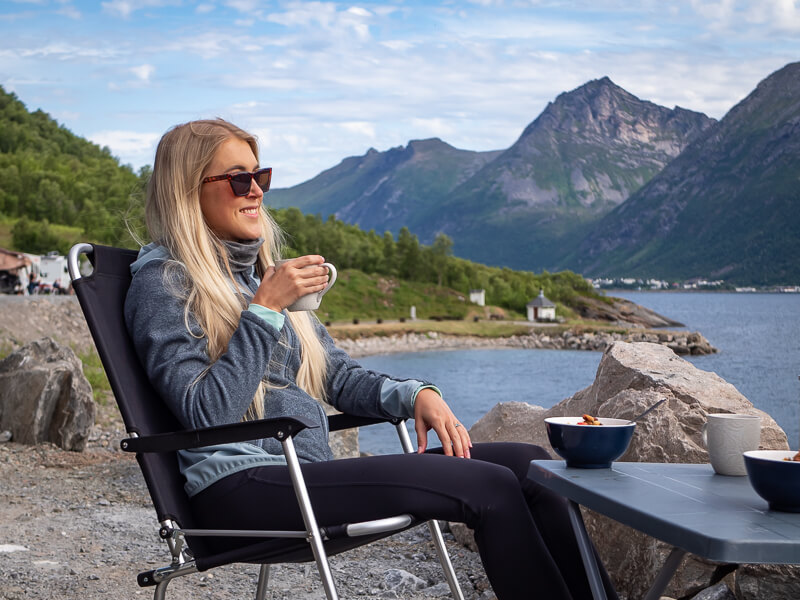
Campsites in Norway
There are many campsites all over the country and they are often situated in scenic areas, next to beaches, fjords or mountains. They usually offer facilities like hot showers, picnic tables, Wi-Fi, washing machines, kitchen areas, electricity hook-ups and small kiosks to buy groceries.
The cost of staying at a campsite in Norway is around 350-500 NOK (30-45 euros) per night for a camper van and a little more for a motorhome or caravan. Showers cost about 20 NOK (1-2 euros) and laundry about 80 NOK (7 euros).
If you’re traveling in the peak season, which is June, July and August, it would be a good idea to give the campsite a call before you arrive and check if they have free spots.
During our Northern Norway campervan trip we had a really great time staying at Lofoten Beach Camp. It’s an awesome campsite with modern facilities, an amazing beachfront location, Arctic surfing lessons, kayak rentals, a beautiful cafe and a sauna with ocean views.
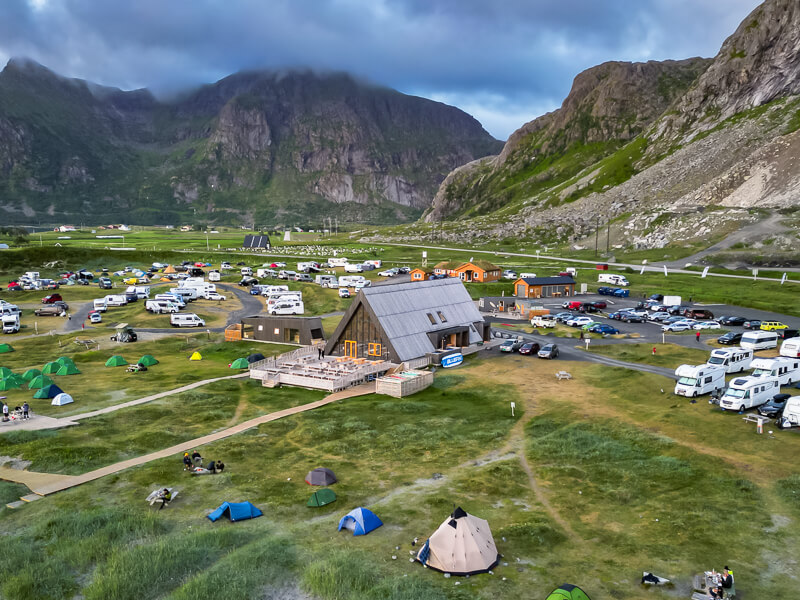
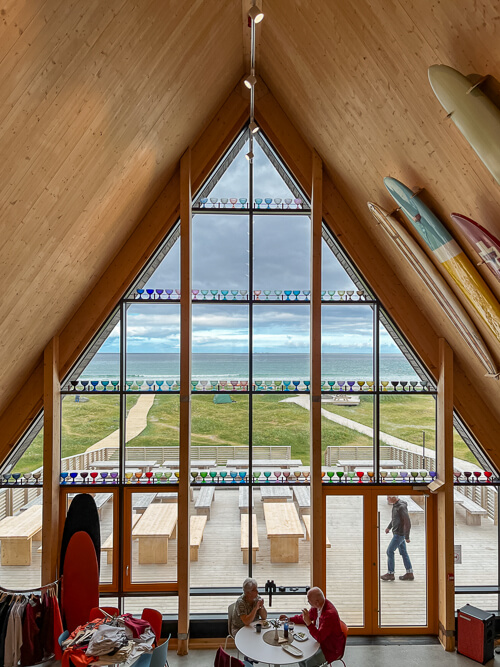
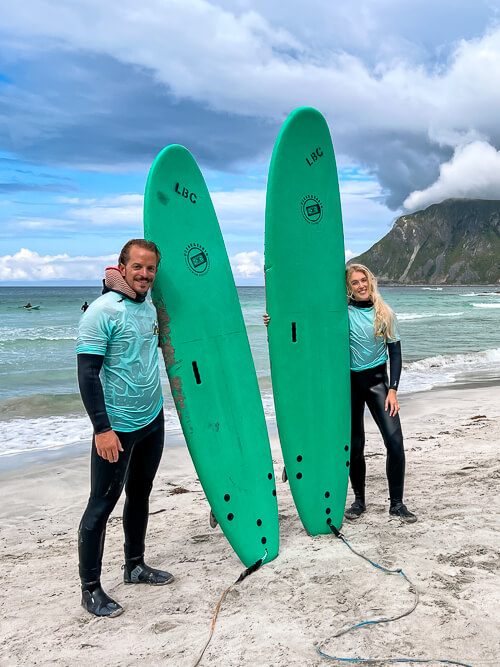
Wild camping
One of the great things about touring Norway by campervan is that you’re allowed to wild camp in a lot of places.
Norway’s Allemannsretten, or the right to roam, dates back to ancient times and gives everyone the right to experience nature, even in privately owned areas. This means that wild camping – also known as free camping – is perfectly legal in Norway as long as you follow a few rules.
Rules for wild camping in Norway:
- The right to roam only applies to ‘open country’, i.e. land that is unfenced and uncultivated. Don’t camp on plowed fields, meadows or in gardens.
- You have to stay at least 150m away from the nearest inhabited house or cabin.
- You can camp for up to two nights in the same place without asking the landowner’s permission, except in very remote areas or mountains.
- Be considerate. Do not disturb the wildlife, damage nature or leave any waste behind.
Note: Don’t expect to find wild camping opportunities in larger cities. There are often signs indicating that overnight parking is prohibited or limited to a few hours for motorhomes and campervans.
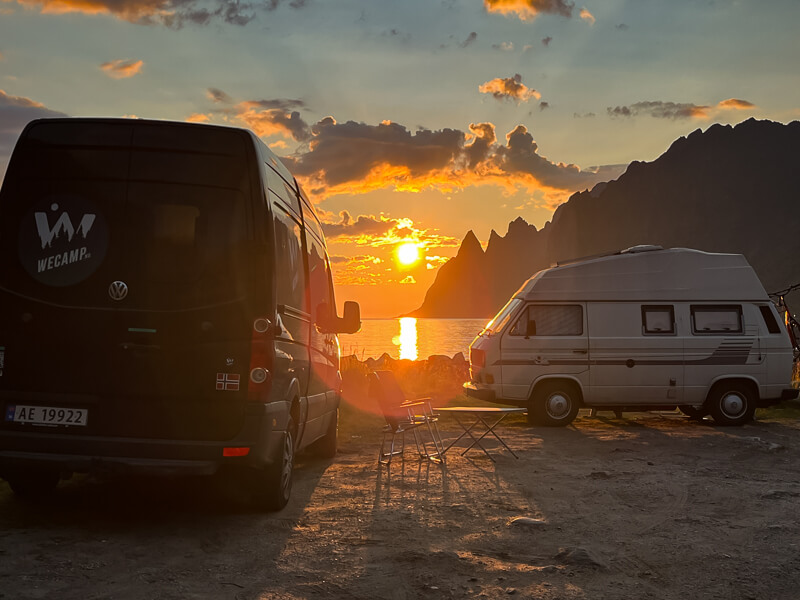
Tips for traveling Norway by campervan
Food & water
As eating out is very expensive in Norway, buying groceries and cooking your own meals will save you a lot of money. The cheapest grocery stores are KIWI, Rema 1000 and Extra. They can be found all over Norway.
Be aware that most grocery stores are closed on Sundays, so time your shopping accordingly.
While you can buy beer in supermarkets, the stronger alcohol is only sold in Vinmonopolet, a government-owned alcohol retailer. Bear in mind that you can’t buy any alcohol in the shops after 8pm on weekdays, 6pm on Saturdays and all day on Sundays.
Tap water in Norway is perfectly safe to drink. In general, you can also drink the water from mountain streams and rivers, just make sure there are no grazing animals around. You can fill up the water tank of your campervan at gas stations, campsites and service points for motorhomes, which are often free to use.
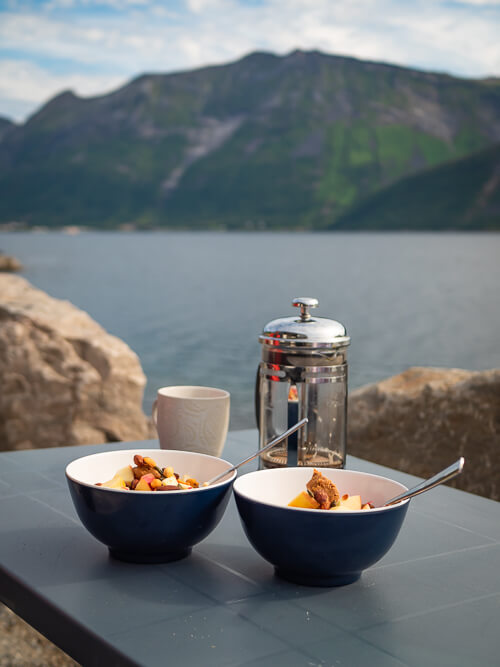
Shower & toilets
There are many public toilets in Norway, they are often free or cost just a few cents and in most cases, they are very clean. You can also find free toilets in gas stations. The campervan that we rented from Wecamp came with a portable toilet, which was great to have when there was no proper toilet around.
In case your campervan doesn’t have a shower or you just prefer a normal shower, you can find them at campsites. You might be allowed to use one even if you’re not staying at the campsite and you usually have to pay around 20 NOK for 5 minutes. Just ask the campsite reception.
An alternative to taking a shower is going for a dip in the sea or in a lake. The water is usually clean and very cold (especially in the regions above the Arctic Circle) and will definitely leave you feeling refreshed!
Waste disposal
Your grey water tank and toilet cassette (if your campervan has one) should only be emptied at motorhome service stations or campsites that have proper facilities for that. The service stations are often free but in some cases, you might need a few coins to empty the toilet cassette.
Look for blue road signs with a motorhome and an arrow pointing down from it to find service points and dump stations or use the Park4Night app.
You should NEVER dump your waste into nature or rivers. Emptying the toilet cassette of your campervan into public toilets is also prohibited.
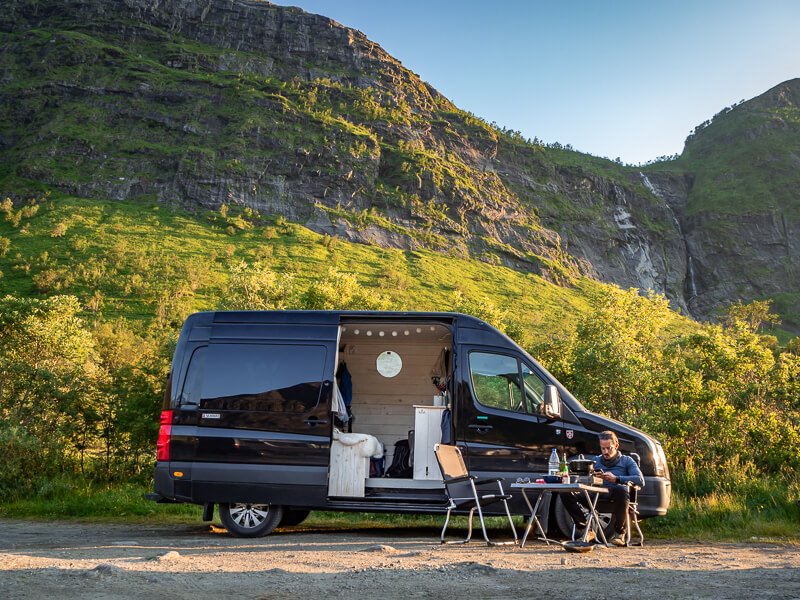
What to pack for your Norway campervan trip
If you’re renting a campervan in Norway, you probably don’t need to bring much on your trip as the vans are usually equipped with almost everything you need. Nevertheless, here are some handy things to have:
- Towels – These are usually not provided by the van rentals or you might have to pay extra for them.
- Sleep mask – If you’re visiting Norway during the Midnight Sun period when it’s bright outside 24 hours a day, it’s a good idea to bring a sleep mask to get a better night’s rest.
- Earplugs – At some campsites or overnight parking spots, there might be loud birds, noisy neighbors or traffic sounds. Bring earplugs if you’re a light sleeper.
- Bug spray – If you’re doing your Norway campervan trip in the summer, a bug spray is a must. While we didn’t see many mosquitoes during our Norway road trip, we did encounter some aggressive horse flies that would have ruined some of our hikes if we hadn’t had a repellent!
- Head torch – Not necessary during the Midnight Sun period but throughout the rest of the year it would be useful to have for the evenings.
- Reusable water bottle – Be kind to the environment and avoid creating unnecessary plastic waste.
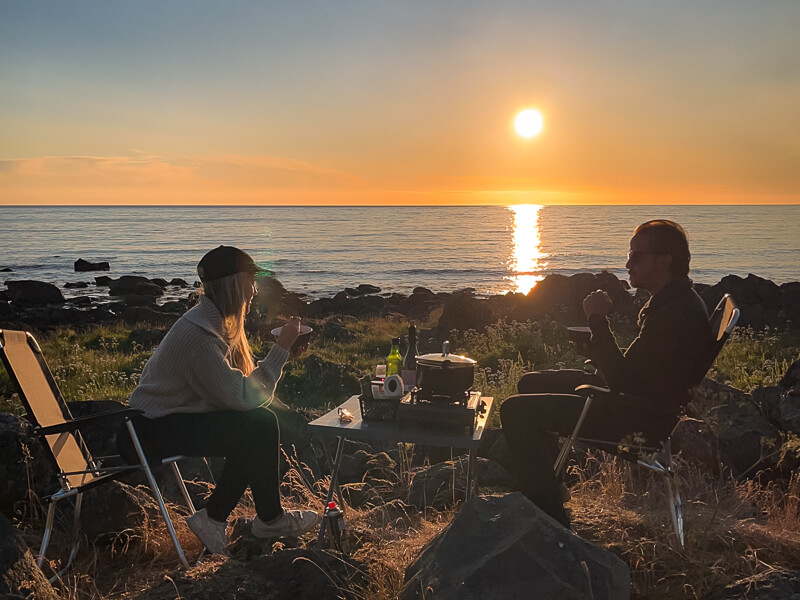
Best time to go campervanning in Norway
May to September
This period is excellent for campervanning in Norway. As the temperatures are warmer and the snow has melted, it’s the perfect time for hiking and enjoying the beautiful nature of Norway.
July and August are the warmest months but they are also the busiest. Expect to see lots of tourists and other campervan enthusiasts.
In the summer, the days are very long so you’ll have many hours each day to explore the country. In Northern Norway, during the Midnight Sun period, the sun won’t set at all so you can just go hiking in the middle of the night if you want! It’s truly a unique experience.
October to April
Winter in Norway can be tough. You should expect lots of snow and freezing temperatures. Therefore, it’s essential that you have a heater in your van. In some parts of Norway, you might also need snow chains for your tires.
As long as you and your van are properly prepared for the weather, winter can offer some wonderful experiences, such as dog sledding, seeing the Northern Lights, snowmobiling, whale watching and skiing. Take a look at my Tromso winter itinerary post and my post on visiting Tromso in December to get an idea of what your winter trip in Norway could look like.
Note that some campsites and waste disposal stations are closed in the winter season. Also, be aware that the days are very short in the winter and that during the Polar Night period in Northern Norway, you’ll only get a few hours of twilight during the day (the sun won’t rise above the horizon).
Norway by campervan: Final thoughts
If you enjoy campervanning or motorhoming, then Norway should definitely be on your bucket list! Our campervan trip there exceeded all my expectations and I cannot wait to go back to explore more of this stunningly beautiful country.
If you have any questions about exploring Norway by campervan, leave them in the comments below.
For more tips to help you plan your trip, take a look at my other Norway travel guides:
- 5-day itinerary for a Lofoten Islands road trip
- Things to know before your trip to Senja Island
- Hiking on the Lofoten Islands – 10 best trails
- Visiting Trollfjord on the Lofoten Islands
- 4-day Tromso itinerary for winter
- 10 beaches you need to visit in Lofoten
- How to hike Reinebringen, Lofoten’s most iconic hike
Enjoyed reading about campervan travel in Norway? Pin it!
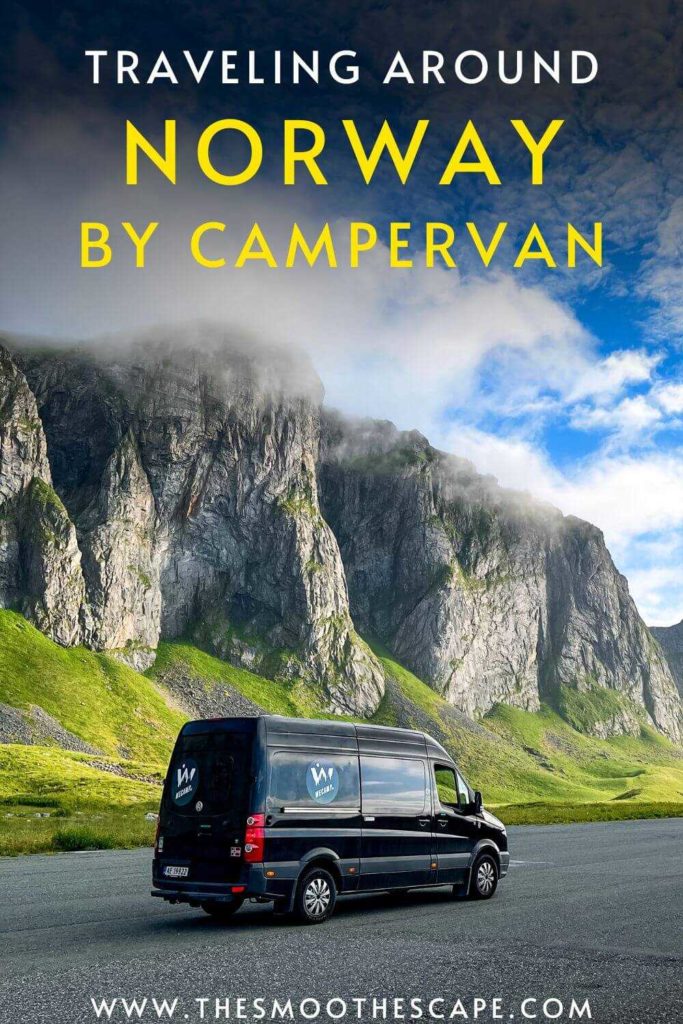
READ MORE:

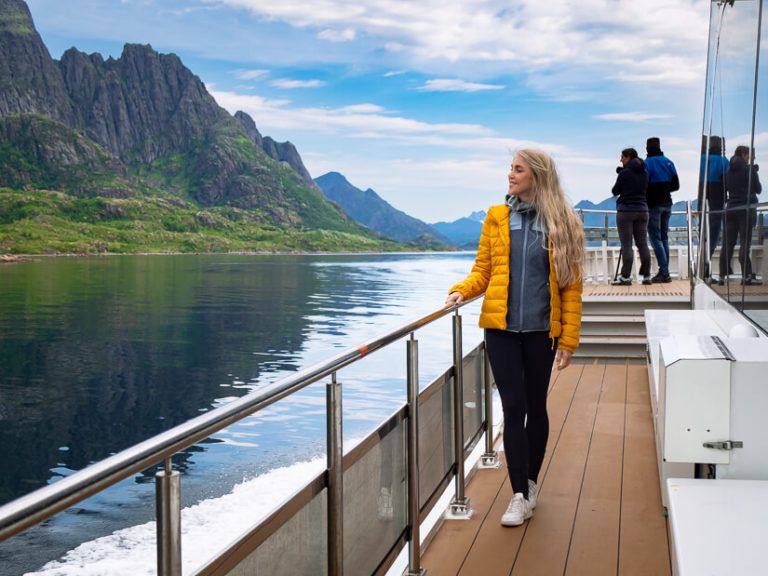
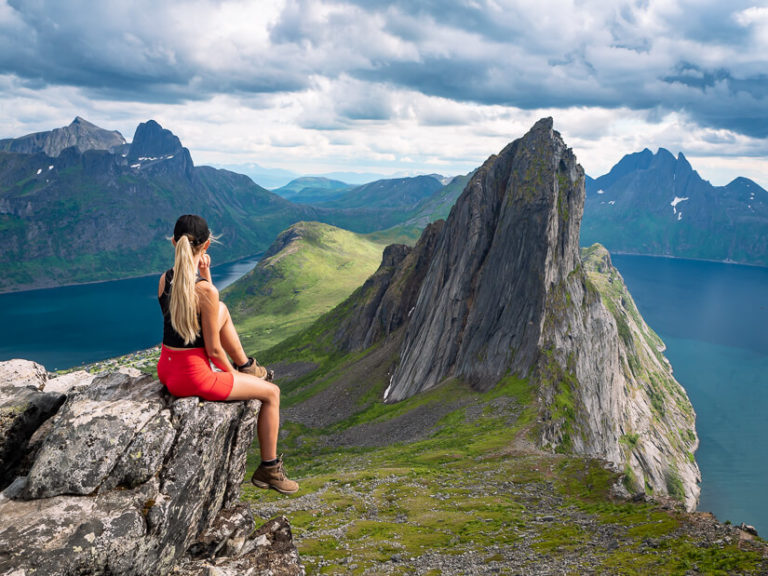
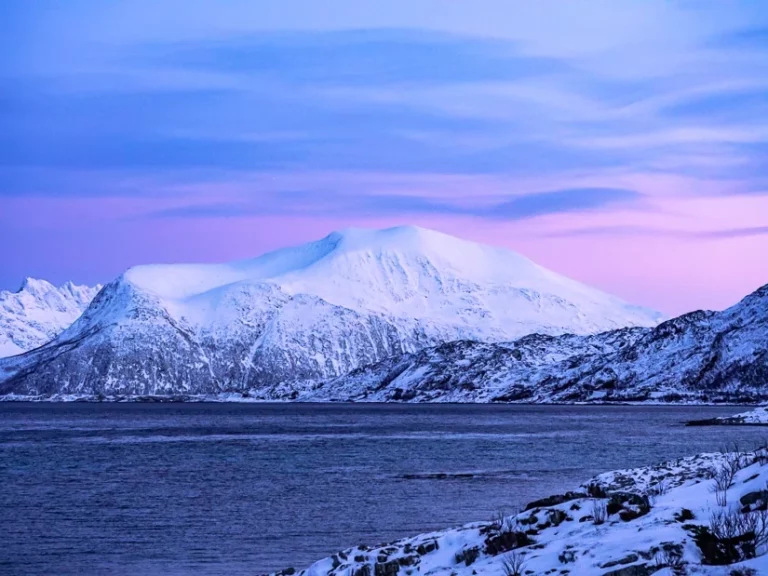
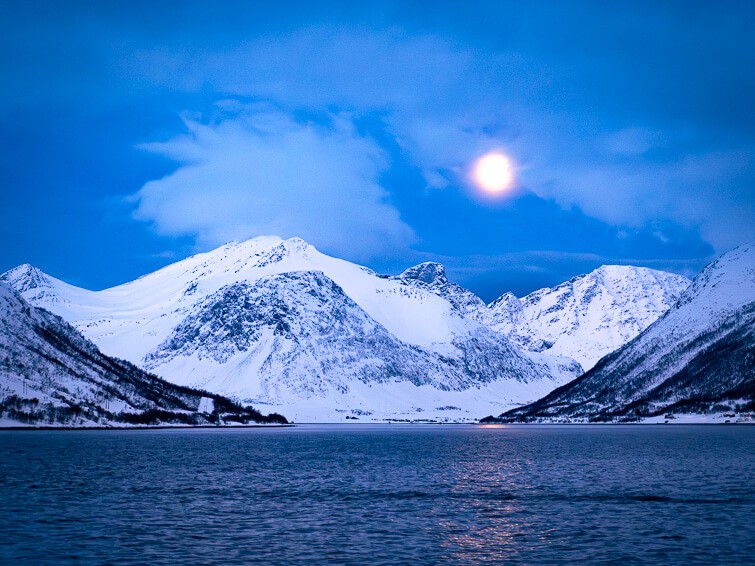
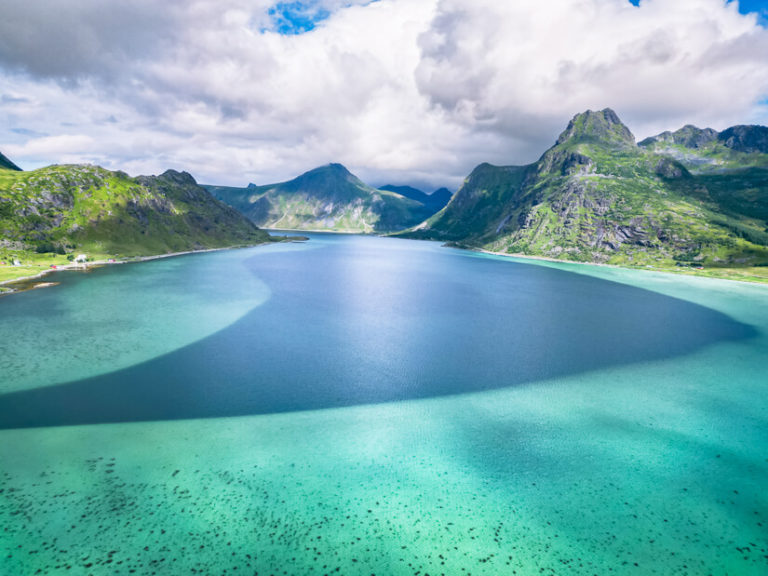
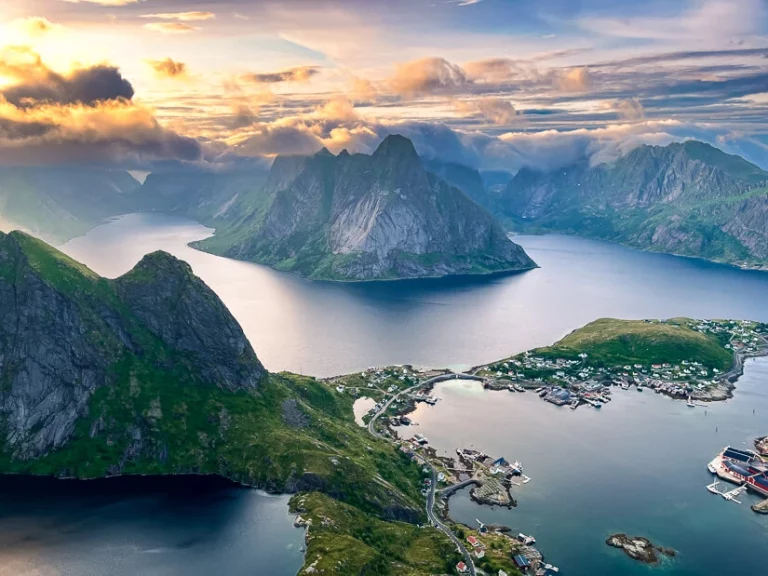
Hi Marjut,
This is a great blog. Thanks very much.
Mt wife and I are planning to go to Trondheim the first of May and rent a campervan. We then want to spend 2 weeks traveling up to the Lofoten Islands and back to Trondhein. Is that enough time to make the drive, hike every day for 1-2 hours and see sights and cultural areas along the route? Also, can you recommend a campervan rental agency in Trondhiem or Bodo?
Thanks for any information you can provide.
Bob Doppelt
Hi Bob. I’m happy to hear you like the blog post! I think 2 weeks sounds like a reasonable amount of time for this kind of trip. I haven’t personally rented a campervan in Trondheim or Bodo but you might want to check out a company called Campervan Norway to see if they have vans in these locations.
Hey, thanks so much for such a useful blog article. I was wondering, did you drive back to Tromso to drop your van off?
Hi Lindsey! You’re welcome! Yes, we drove back to Tromso with the van.
I need to point out the fact that “Allemannsretten” does NOT apply to motorized vehicles, only camping with a tent and similar. For a camper van, regular parking regulations apply.
Hi Micke. Visit Norway says otherwise (they say that “this rule also applies to vans, mobile homes, and caravans”). Visit Lofoten also states that you can park a mobile home wherever you wish for up to two nights, unless there are clear signs prohibiting it. People obviously shouldn’t drive their campervans/motorhomes off-road – I think that’s implicit.
Hi!!
Great Vlog. Thank you for doing this. I plan on doing this one day. Great information. And external links. 🙂
Planning for an October month. Long journey from Canada 🙂
Hi Jeanette. I’m glad to hear you like the post. 🙂 It’s a long journey from Canada indeed but I’m sure it will be worth it! It’s such an amazing country to explore by campervan.
Hi Micke,
We are renting with WeCamp in July & wanted to know if you were able to rent portable wi-fi through them. If not, how did you handle web access on the road?
Thanks,
Jen
Hi Jen.
My name is Marjut not Micke 🙂 . We didn’t rent portable wifi. We just used data on our phones.
Hi Marjut,
Thanks for all the tips and advice! I will be following a similar Lofoten road trip you highlighted in another blog post!
I’m about to be there in late June and am wondering if you ever had any problems with the camper getting too hot while sleeping (especially if parked in the sun). And if so what you did to keep cool.
Thanks,
Jack
Hi Jack. You’re welcome! We never had a problem with the van getting too hot. Lofoten is a rather cold destination so heat was never an issue. We actually turned on the heater in our van a few times. Have a great trip!
Absolute agree to this great blog,
Recently finished a round road trip up to Alesund by a suv and stayed over hotels and cabins. I and my wife can not agree any more with Marjut’s blog on camper van trip with lots of tips and know-hows. We are already planning to have second round trip with a camper, wild camping at North. Thanks again for this great blog.
JT&JK
You’re welcome!
Hi, thank your very much for all the useful information.
We are planning a caravan trip this coming November. May I know where can we recharge the van as we plan to do some wild camping. And may I know how much is the total u spend on tolls for the whole trip?
Thank you very much.
Hi Benjamin. You’re welcome! I’m not really sure but you might be able to charge your van at some campsites. We never had the need to do that though because the battery of the van recharges while you drive. We didn’t spend any money on tolls, there are no toll roads in the north where we were (Tromso, Senja, Lofoten).
Finally we found a great blog with campervan in Norway.
We are going in late September to early October, planning to do tromso- looften- tromso. Do you have any idea if it would be feasible ?
Hi Dee. I think you’ll be fine as long as you have heating in your van.
We are planning to go in the same dates! Hopefully the camps will still be open?
Some camps will start closing in October. I recommend checking their websites for specific dates. You’ll have plenty of spots to free camp though.
Hi! Many thanks for all tips you shared 🙂
You’re welcome!
Hey Marjut,
Great read! My partner and I will be visiting the Lofoten islands in June, flying into Harstad airport. We’d love to do the camper van a few nights, but are also hoping to stay in some airbnbs a few nights. What advice do you have for those who are trying to use a camper van for only a portion of their trip? Just not sure how to go about coordinating two rentals when it comes to pick up / drop off locations.
Thanks 🙂
Hi Jesse. Thank you! I don’t think there’s any good way to do it this way unfortunately. You could rent a campervan in Harstad and drive it to Lofoten for a few nights but then you’d have to return it at the airport again and pick up a regular car and thereby waste a lot of time driving back and forth. You could rent a campervan for your whole trip and sleep in Airbnbs instead of the van for a few nights but that is of course not the most economical option.
Greetings Marjut,
Fascinating blog about campervan travel in Norway! Many thanks. We travel to Norway from 24 May 2025 (with my wife, 9 year old daughter and my father and mother in law; 5 people in total) and return on 04 June 2025. I would have to rent the “bigger” campervans / motorhome for 5 persons and travel route is Trondheim – Geiranger – Bergen – Flam – Oslo.
– Do you think the No. of days are adequate for this route ?
– Can you shre the fuel consumption for your campervan ?
Thanks again.
Hi! I’m glad to hear you liked the post! Unfortunately, I’m not able to help you with the questions. I have never done the travel route you’re planning to do and I can’t remember how much fuel our van consumed. I hope you’ll have a fantastic trip!
Hi Marjut,
My compliments on a charming, well-written, informative and fun blog. Good going! Regarding vanlife travel in Norway…thinking about an occasional stay at a hotel or inn to break up the camping/glamping in the van — what are your thoughts about last minute availability during the August season? Sure, I can sleep in the campervan, but just _if_ I wanted to splurge here and there, what are your thoughts of summertime availability. Summertime = August.
Thanks so much!
When you get to Japan, look us up!! Seriously.
Cheers. Curt and Meg
Hi Curt.
Thanks a lot, glad to hear you enjoyed the blog post! Regarding your question, even though summer is a popular season in Lofoten, I think you’ll be able to find some last minute accommodation. My guess is that cheaper places will be sold out but pricier ones will have some availability.
I’ll keep you guys in mind if I ever plan a trip to Japan! 🙂